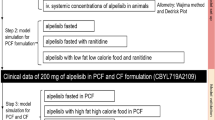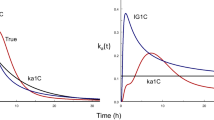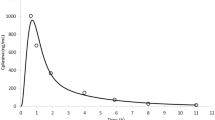Abstract
Purpose
To compare the pharmacokinetics of intravenous (IV), oral immediate-release (IR) and oral modified-release (MR) formulations of mavoglurant in healthy subjects, and to assess the food effect on the MR formulation’s input characteristics.
Methods
Plasma concentration-time data from two clinical studies in healthy volunteers were pooled and analysed using NONMEM®. Drug entry into the systemic circulation was modelled using a sum of inverse Gaussian (IG) functions as an input rate function, which was estimated specifically for each formulation and food state.
Results
Mavoglurant pharmacokinetics was best described by a two-compartment model with a sum of either two or three IG functions as input function. The mean absolute bioavailability from the MR formulation (0.387) was less than from the IR formulation (0.436). The MR formulation pharmacokinetics were significantly impacted by food: bioavailability was higher (0.508) and the input process was shorter (complete in approximately 36 versus 12 h for the fasted and fed states, respectively).
Conclusions
Modelling and simulation of mavoglurant pharmacokinetics indicate that the MR formulation might provide a slightly lower steady-state concentration range with lower peaks (possibly better drug tolerance) than the IR formulation, and that the MR formulation’s input properties strongly depend on the food conditions at drug administration.







Similar content being viewed by others
Abbreviations
- BQL:
-
Below the quantification limit
- BW:
-
Actual bodyweight
- CL:
-
Plasma clearance
- IG:
-
Inverse Gaussian
- IMPMAP:
-
Monte Carlo importance sampling method assisted by mode a posteriori with interaction
- IR:
-
Immediate-release
- ISV:
-
Intersubject variability
- IV:
-
Intravenous
- mGluR5:
-
Metabotropic glutamate receptor 5
- MR:
-
Modified-release
- OFV:
-
Objective function minimum value
- Q:
-
Inter-compartmental clearance
- Vc:
-
Volume of distribution of the central compartment
- Vp:
-
Volume of distribution of the peripheral compartment
REFERENCES
Glass IA. X linked mental retardation. J Med Genet. 1991;28:361–71.
Brown WT, Jenkins EC, Cohen IL, Fisch GS, Wolf-Schein EG, Gross A, et al. Fragile X and autism: a multicenter survey. Am J Med Genet. 1986;23:341–52.
Li SY, Chen YC, Lai TJ, Hsu CY, Wang YC. Molecular and cytogenetic analyses of autism in Taiwan. Hum Genet. 1993;92:441–5.
Estecio M, Fett-Conte AC, Varella-Garcia M, Fridman C, Silva AE. Molecular and cytogenetic analyses on Brazilian youths with pervasive developmental disorders. J Autism Dev Disord. 2002;32:35–41.
Reddy KS. Cytogenetic abnormalities and fragile-X syndrome in autism spectrum disorder. BMC Med Genet. 2005;6:3.
Bagni C, Tassone F, Neri G, Hagerman R. Fragile X syndrome: causes, diagnosis, mechanisms, and therapeutics. J Clin Invest. 2012;122:4314–22.
Dolen G, Carpenter RL, Ocain TD, Bear MF. Mechanism-based approaches to treating fragile X. Pharmacol Ther. 2010;127:78–93.
Levenga J, Hayashi S, de Vrij FM, Koekkoek SK, van der Linde HC, Nieuwenhuizen I, et al. AFQ056, a new mGluR5 antagonist for treatment of fragile X syndrome. Neurobiol Dis. 2011;42:311–7.
Gantois I, Pop AS, de Esch CE, Buijsen RA, Pooters T, Gomez-Mancilla B, et al. Chronic administration of AFQ056/Mavoglurant restores social behaviour in Fmr1 knockout mice. Behav Brain Res. 2013;239:72–9.
Pop AS, Levenga J, de Esch CE, Buijsen RA, Nieuwenhuizen IM, Li T, et al. Rescue of dendritic spine phenotype in Fmr1 KO mice with the mGluR5 antagonist AFQ056/Mavoglurant. Psychopharmacology. 2014;231:1227–35.
Jacquemont S, Curie A, des Portes V, Torrioli MG, Berry-Kravis E, Hagerman RJ, et al. Epigenetic modification of the FMR1 gene in fragile X syndrome is associated with differential response to the mGluR5 antagonist AFQ056. Sci Transl Med. 2011;3:64ra61.
Walles M, Wolf T, Jin Y, Ritzau M, Leuthold LA, Krauser J, et al. Metabolism and disposition of the metabotropic glutamate receptor 5 antagonist (mGluR5) mavoglurant (AFQ056) in healthy subjects. Drug Metab Dispos. 2013;41:1626–41.
Berg D, Godau J, Trenkwalder C, Eggert K, Csoti I, Storch A, et al. AFQ056 treatment of levodopa-induced dyskinesias: results of 2 randomized controlled trials. Mov Disord. 2011;26:1243–50.
Stocchi F, Rascol O, Destee A, Hattori N, Hauser RA, Lang AE, et al. AFQ056 in Parkinson patients with levodopa-induced dyskinesia: 13-week, randomized, dose-finding study. Mov Disord. 2013;28:1838–46.
Custodio JM, Wu CY, Benet LZ. Predicting drug disposition, absorption/elimination/transporter interplay and the role of food on drug absorption. Adv Drug Deliv Rev. 2008;60:717–33.
Zhou H. Pharmacokinetic strategies in deciphering atypical drug absorption profiles. J Clin Pharmacol. 2003;43:211–27.
Jakab A, Winter S, Raccuglia M, Picard F, Dumitras S, Woessner R, et al. Validation of an LC-MS/MS method for the quantitative determination of mavoglurant (AFQ056) in human plasma. Anal Bioanal Chem. 2013;405:215–23.
Beal SL, Sheiner LB, Boeckmann AJ, Bauer RJ. NONMEM 7.2.0 users' guides. Ellicott City: ICON Development Solutions; 2011.
Lindbom L, Pihlgren P, Jonsson EN. PsN-Toolkit–a collection of computer intensive statistical methods for non-linear mixed effect modeling using NONMEM. Comput Methods Prog Biomed. 2005;79:241–57.
R.D.C. Team. R: a language and environment for statistical computing. Vienna: R Foundation for Statistical Computing; 2009.
Savic RM, Jonker DM, Kerbusch T, Karlsson MO. Implementation of a transit compartment model for describing drug absorption in pharmacokinetic studies. J Pharmacokinet Pharmacodyn. 2007;34:711–26.
Holford NH, Ambros RJ, Stoeckel K. Models for describing absorption rate and estimating extent of bioavailability: application to cefetamet pivoxil. J Pharmacokinet Biopharm. 1992;20:421–42.
Karlsson MO, Sheiner LB. The importance of modeling interoccasion variability in population pharmacokinetic analyses. J Pharmacokinet Biopharm. 1993;21:735–50.
Beal SL. Ways to fit a PK model with some data below the quantification limit. J Pharmacokinet Pharmacodyn. 2001;28:481–504.
Csajka C, Drover D, Verotta D. The use of a sum of inverse Gaussian functions to describe the absorption profile of drugs exhibiting complex absorption. Pharm Res. 2005;22:1227–35.
Weiss M. A novel extravascular input function for the assessment of drug absorption in bioavailability studies. Pharm Res. 1996;13:1547–53.
Gueorguieva I, Ogungbenro K, Graham G, Glatt S, Aarons L. A program for individual and population optimal design for univariate and multivariate response pharmacokinetic-pharmacodynamic models. Comput Methods Prog Biomed. 2007;86:51–61.
Duffull SB, Dooley MJ, Green B, Poole SG, Kirkpatrick CM. A standard weight descriptor for dose adjustment in the obese patient. Clin Pharmacokinet. 2004;43:1167–78.
Savic RM, Karlsson MO. Importance of shrinkage in empirical bayes estimates for diagnostics: problems and solutions. AAPS J. 2009;11:558–69.
Bergstrand M, Karlsson MO. Handling data below the limit of quantification in mixed effect models. AAPS J. 2009;11:371–80.
Shen J, Boeckmann A, Vick A. Implementation of dose superimposition to introduce multiple doses for a mathematical absorption model (transit compartment model). J Pharmacokinet Pharmacodyn. 2012;39:251–62.
Martinez MN, Amidon GL. A mechanistic approach to understanding the factors affecting drug absorption: a review of fundamentals. J Clin Pharmacol. 2002;42:620–43.
Karmakar MK, Ho AM, Law BK, Wong AS, Shafer SL, Gin T. Arterial and venous pharmacokinetics of ropivacaine with and without epinephrine after thoracic paravertebral block. Anesthesiology. 2005;103:704–11.
Kirchheiner J, Brockmoller J, Meineke I, Bauer S, Rohde W, Meisel C, et al. Impact of CYP2C9 amino acid polymorphisms on glyburide kinetics and on the insulin and glucose response in healthy volunteers. Clin Pharmacol Ther. 2002;71:286–96.
Lotsch J, Weiss M, Ahne G, Kobal G, Geisslinger G. Pharmacokinetic modeling of M6G formation after oral administration of morphine in healthy volunteers. Anesthesiology. 1999;90:1026–38.
Zhang X, Nieforth K, Lang JM, Rouzier-Panis R, Reynes J, Dorr A, et al. Pharmacokinetics of plasma enfuvirtide after subcutaneous administration to patients with human immunodeficiency virus: Inverse Gaussian density absorption and 2-compartment disposition. Clin Pharmacol Ther. 2002;72:10–9.
Chhikara R, Folks JL. The inverse Gaussian distribution as a lifetime model. Technometrics. 1977;19:461–8.
Tannergren C, Bergendal A, Lennernas H, Abrahamsson B. Toward an increased understanding of the barriers to colonic drug absorption in humans: implications for early controlled release candidate assessment. Mol Pharm. 2009;6:60–73.
Olivares-Morales A, Kamiyama Y, Darwich A, Aarons L, Rostami-Hodjegan A. Analysis of the impact of controlled release formulations on oral drug absorption, gut wall metabolism and relative bioavailability of CYP3A substrates using a physiologically-based pharmacokinetic model. Eur J Pharm Sci. 2014. doi:10.1016/j.ejps.2014.10.018.
Weitschies W, Wedemeyer RS, Kosch O, Fach K, Nagel S, Soderlind E, et al. Impact of the intragastric location of extended release tablets on food interactions. J Control Release Off J Control Release Soc. 2005;108:375–85.
ACKNOWLEDGMENTS AND DISCLOSURES
The authors thank Nikolaos Tsamandouras (Manchester Pharmacy School, The University of Manchester, Manchester, United-Kingdom), for providing technical support including the methodology on the use of the logistic-normal distribution; Andres Olivares-Morales (Manchester Pharmacy School, The University of Manchester, Manchester, United-Kingdom) for the invaluable discussions on absorption mechanisms; Subramanian Ganesan (Drug Metabolism and Pharmacokinetics, Novartis Institutes for Biomedical Research, Hyderabad, India) for the useful discussions on mavoglurant pharmacokinetics.
Author information
Authors and Affiliations
Corresponding author
Electronic supplementary material
Below is the link to the electronic supplementary material.
ESM 1
(DOCX 1.01 MB)
Rights and permissions
About this article
Cite this article
Wendling, T., Ogungbenro, K., Pigeolet, E. et al. Model-Based Evaluation of the Impact of Formulation and Food Intake on the Complex Oral Absorption of Mavoglurant in Healthy Subjects. Pharm Res 32, 1764–1778 (2015). https://doi.org/10.1007/s11095-014-1574-1
Received:
Accepted:
Published:
Issue Date:
DOI: https://doi.org/10.1007/s11095-014-1574-1




